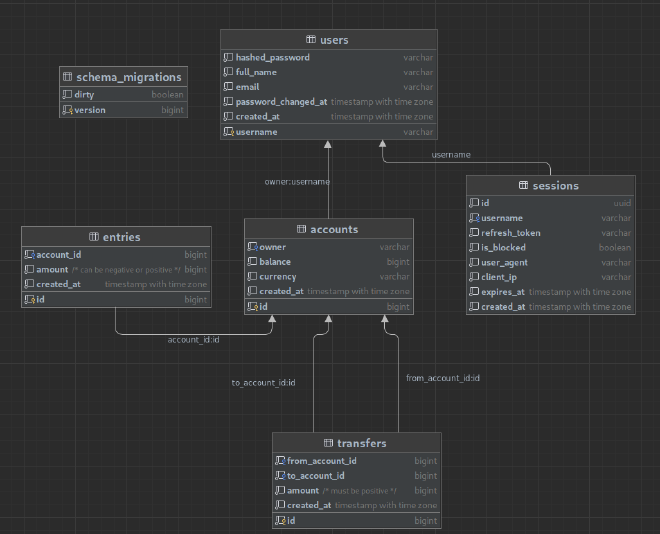In this article I’ll be talking about my latest but not the least project on go gobank
The project is a simple implementation of a bank service
I have learned a lot of tools/libs on this course like
- gin
- grpc
- protobuf
- sqlc
- Makefile
And that is just to name a few
Simple Bank API Built with golang
Now let’s actually dive in what this project is all about
Structure
I am only going to mention the most important dirs
Database
db is the dir responsible to handel all the following
- make db transaction(with tests)
- store schema & queries used by sqlc to generate
- sqlc generated code to interact with db
mock dbwhich is a sub package underdbthat just mocks the db calls, extensively used in api testing
So now I think it might be a good time to show the db schema of that project

Actually working with sqlc was so useful since it automates a lot of db stuff instead of making it yourself, I also prefer to use it over gorm because first it is faster & it strengths you sql in some manner since you will have to write some queries by yourself.
So in the next section I’ll be going on depth on how interactions with the db.
API
In this project I decided to go with gin a go web framework.
It had a lot of features that eases the handling of requests
- request params validations
- error handling
- convenient interface functions to work with
- bind data from json, uri & query
So in short the gin server was handling the following request
Endpoints
router := gin.Default()
authGroup := router.Group("/").Use(authMiddleware(server.tokenMaker))
{
// Account Routes
authGroup.POST("/api/accounts", server.createAccount)
authGroup.GET("/api/accounts/:id", server.getAccount)
authGroup.GET("/api/accounts", server.listAccounts)
authGroup.DELETE("/api/accounts/:id", server.deleteAccounts)
// Transfer Routes
authGroup.POST("/api/transfers", server.createTransfer)
// User Routes
authGroup.GET("api/users/:username", server.getUser)
authGroup.PATCH("api/users", server.updateUser)
}
// Unauthenticated Routes
router.POST("api/users", server.createUser)
router.POST("api/users/login", server.loginUser)
router.POST("api/users/renew", server.renewAccessToken)
server.router = routerAs you can see some requests require authentication, for token creating and verifying I used paseto,
Which is a very powerful secured token issuer, even better than JWT, But anyway I have implemented both approaches to get the most out of this project.
Here is the token makers implementation
gapi
Well now we are getting to the most important part of this project, the gapi package
It was the first time I was working with grpc and protobuf and I have to say it was a great experience since it is a very powerful tool to work with.
In the grpc server I didn’t implement all the endpoints, that was implemented in the gin server, but I did implement the following
// Auth gRPC calls
rpc Login(LoginRequest) returns (LoginResponse) {}
// service created but not implemented
rpc Logout(LogoutRequest) returns (google.protobuf.Empty) {}
// User gRPC calls
rpc CreateUser(UserRequest) returns (UserResponse) {}
rpc GetUser(Username) returns (UserResponse) {}
rpc UpdateUser(UserUpdateRequest) returns (UserResponse) {}
rpc DeleteUser(Username) returns (google.protobuf.Empty) {}For more in depth check the gapi dir
So yeah, that’s all for this article it was a nice project to work on and have learned a lot from it.
I hope you enjoyed it and if you have any questions or suggestions feel free to contact me on telergram